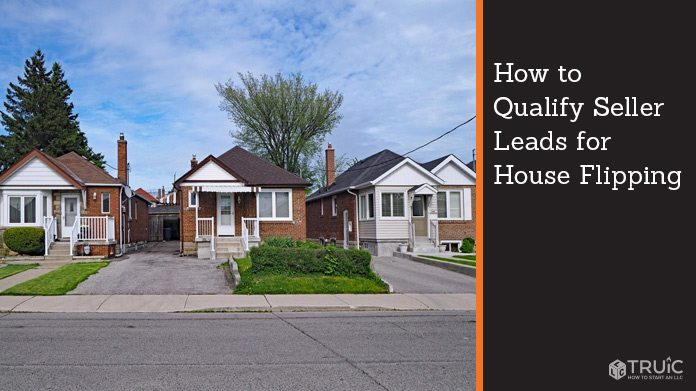How to Qualify Seller Leads for House Flipping
When you qualify house flipping leads, you weed out leads that are not worth your time to follow up with. This will save you time and guarantee that you find a great house to flip.
Discover real estate investing strategies that'll help you quickly and accurately qualify house flipping leads. Read on to learn the three steps to qualify a house for flipping and the questions to ask to qualify a seller.
Recommended: Be sure to read our guide on How to Start a Real Estate Investing Business.

Qualifying a House for Flipping
When you get a lead on a house to flip, the first three questions you should ask are:
- Is it in your target neighborhood(s)?
- Is it a neighborhood misfit?
- Is it in satisfactory condition?
You want a house that is in your target neighborhood, that is not a neighborhood misfit, and that is in satisfactory condition. If you can confirm these three questions, it is a lead worth pursuing.
Target Neighborhood
You want a house in your target neighborhood because you have done the research, and you already know you can get a good return on investment. It is worthwhile to double-check the price and the current selling activity if you selected the target neighborhood six months or more prior. However, a location within your target neighborhood is usually a good first step for a successful house flip.
Remember, your target neighborhood should meet the following six criteria:
- Good sales activity of homes in the area
- Selling price points of two distinct levels of homes
- Age of the house
- Charm and desirability of the area
- Safety of the neighborhood
- Vicinity of your work and home
You should already be familiar with the target neighborhood. Now you just need to assess whether the house fits in and meets the criteria.
Neighborhood Misfits
You want to make sure that the house you plan to flip fits in with the other houses in the neighborhood. A flat-roofed, modern home in a neighborhood filled with colonial homes will not fit in.
If the style of the house is dramatically different from the other homes in the neighborhood, it is a misfit. Neighborhood misfits, even if they are beautiful or charming, will not sell well. They are not a good choice for your first house flips.
You can define a neighborhood misfit as a house that has an outward appearance that will be too difficult or costly to change to fit in with the neighborhood norms. Here’s a list of some things to look out for:
- Irregular lot: This can be a lot that is too small, too steep, a strange shape, or otherwise less desirable than others in the neighborhood.
- Unusual architecture: This can be something visually strange that doesn’t fit with the other houses in the neighborhood. Check roof pitch, elevation, and overall size and shape of the house.
- Irregular layout: This can include an unusually small kitchen without space to remodel, one bathroom in a 4 bedroom house, narrow hallways, etc. An irregular layout will be obvious in your walkthrough. You want to avoid anything that makes the interior feel strange or cramped and cannot easily be renovated.
- House Size: Be sure that the house is not vastly larger or smaller than the other houses in the neighborhood. If the average home size in the neighborhood is 3,000 square feet, an 800 square foot house would be the neighborhood misfit.
- Neighboring Buildings: Check that the surrounding buildings are not the misfits of the neighborhood. Be wary of large commercial buildings, oversized houses, or any lots that are eyesores.
- Street desirability: Check that the street is not unusually busy. Avoid parking issues due to schools, offices, or other restrictions.
- Infrastructure at a distance: You want easy access, but you don’t want infrastructure so close that it disturbs the house. Check for highways, railroad tracks, power lines, cell phone towers, retention ponds, and anything else potentially disturbing. Many of these will influence the whole neighborhood, but make sure your house isn’t the most affected by this infrastructure.
- Crime-free: If you know about the crime, chances are future buyers will find out as well. If a crime happened in the house, it can scare off potential buyers. Know your local market to access your risk. Consider carefully before purchasing a house that was the scene of a crime or tragedy.
Generally, buyers searching in a specific neighborhood are looking for a house that meets the neighborhood norm. If it is a neighborhood misfit, you may be able to get a return on your investment but only if you offer a lower selling price and are prepared for a longer waiting time to sell.
It is better to choose a house that is not a neighborhood misfit for your first house flips.
Satisfactory Condition
To determine whether the house is in satisfactory condition, you can ask leading questions to get a general idea of the level of damage and need of repair. What each investor considers as a satisfactory condition of a house will vary.
We recommend you avoid houses with major structural damage for at least your first few house flips and until you are confident in the process. Some real estate investors will never take on houses with major structural damage.
When you are checking if a house is in satisfactory condition, start outside at the base and work up.
Major issues to avoid include:
- Major foundation problems
- Roof damage or collapsed
- Water damage
- Fire damage
- Lead paint
- Asbestos
- Termite damage
- Aluminum wiring
- Uneven floors or sloping foundation
- Lead pipes
Get a contractor to help you assess if you see:
- Cracked or collapsing walls
- Crumbling concrete
- Sagging ceiling
- Rotting timber
- Gaps between walls
- Water sitting either inside or outside the house
- Digging around the house
- Visible sanitation or water lines
Once you have determined that there are no red flags for structural damage, you can move forward. A house in your target neighborhood, that is not the neighborhood misfit and that is in satisfactory condition, is a qualified house flipping lead.
With this information, it is worth your time to pursue the purchase and flip of this house. The only step remaining is to qualify the seller.
Qualifying a Seller for House Flipping
Once you know the house meets your criteria, it is time to speak to the seller. To be qualified, the seller must be willing and able to sell the house for less than the retail market value. The retail market value is the price at which a typical home buyer would purchase the property.
A qualified seller will have the motivation to sell quickly. Ideally, they will also have the means to sell quickly, but your main priority will be locating a motivated seller. A motivated seller, regardless of other factors, will be a qualified seller.
The Motivation to Sell Below Market Value
A seller may not want to deal with the hassle of selling and find themselves motivated to sell quickly. Your ability to sell quickly can help these sellers avoid or get out of difficult situations. Think of yourself as an angel investor, helping motivated sellers at the time when they just want to finish the purchase and avoid the hassle.
There are a variety of life events including financial hardship, illness, or vacancy that will increase the motivation of a seller. Here are a few examples.
Factors that make a motivated seller include:
- Relocation to another city for job or family
- Divorce and selling to divide assets
- Physical inability to maintain property (such as old age or illness)
- Inability to make house payments
- A second mortgage because of a new house
- Unaffordable cost of repairs and forced sell
- Desire to downsize
- Too many repairs or too busy to fix the house
- Wants to avoid remote management of repairs
- Inability to rent the property
- Inherited property and wants to sell
The Means to Sell Below Market Value
With a motivated seller, you need to help them determine if they also have the means to sell. Even if they don’t have the means, they may be ready to sell.
A homeowner that has the means to sell below market value will have either equity in the house, cash to pay off the loan, or an agreement with the lender.
- Equity in the house means that they have partially paid off the mortgage. This gives the seller flexibility to accept less than the full value for the house during the sale. For example, if the retail market value of the house is $250,000, but the homeowner has already paid $100,000 in equity, they will be able to accept a lower price. Someone with substantial equity in a home would only be motivated to sell for extreme reasons such as a need to relocate quickly, illness, or a major loss.
- Cash to pay off the loan means that the homeowner has other means to pay the difference between the mortgage value and the purchase price. This is most common in houses that were inherited. Homeowners that have taken on a second mortgage may also have cash to pay off the first mortgage and just want a quick sale.
- An agreement with the lender is a unique situation that usually happens during the foreclosure process. In these cases, the lender has agreed to reduce the loan to facilitate a quick purchase. This saves the lender and the seller the hassle of marketing the property. This is the most common option you will find when qualifying house flipping leads.
Once you have determined that a seller has the motivation as well as the means to sell below market value, you have a qualified seller.
Qualifying a Seller Without Means
However, even if the seller does not have the means to sell, a motivated seller might want to make it work. You need to convince the seller that you will solve their problems with a quick, no-hassle sale and work together to close the real estate deal.
The best way to do this is to work with them to reach a selling price, even if it is lower than the value they would like to get.
A seller without means is a good lead. As the house flipper the challenge is providing a solution for their current challenge.
The Qualifying Conversation
This is where you reach out to the seller to assess whether they have the means and the motivation to sell. You can then decide whether to confirm that house as a qualified lead. Consider this step a networking opportunity. Sellers may lead you to other properties or investors that can also become qualified leads or future partners.
When you speak to the seller, be mindful of time. These calls are purposeful and friendly investigations. You will be confirming your initial research regarding the state of the property and the motivation of the seller.
Your primary purpose in these qualifying conversations is to convince the seller that you are the solution to their problem.
After this conversation, you should know if:
- The house meets your buying criteria.
- The seller has the means and motivation to sell.
- The seller understands your offer and value proposition.
- There are other opportunities this seller can lead you to.
The most important part of the qualifying conversation is to really listen to the homeowner’s answers. If a seller discloses any kind of urgency, then this is an indication that they are a clear qualifier. This can be anything from tedious repairs to financial or personal concerns.
Your job here is to listen and assess the situation. Emotional involvement from the side of the buyer will dictate the purchase price. A motivated seller is often emotionally distressed and ready to finalize the purchase to solve a problem.
Here are some of the questions you can ask to get the qualifying conversation started.
Questions to Ask When Qualifying a Seller
- Why are you interested in selling?
- How quickly do you want to sell?
- How long have you owned the house?
- Are you the sole owner of the house?
- Is anyone living in the house?
- Are the payments up to date?
- Do you remember how much you paid for the house?
- Is there a mortgage? How much of the mortgage is left to be paid off?
- Do you have an asking price in mind?
- Are there any liens or judgments on the property that you’re aware of?
To make the most of your call, gather as much information ahead of time as you can. That way you can focus on the most important questions and any missing information during the qualifying conversation.
Putting It All Together
Qualifying a lead means doing thorough research to determine if a property meets your criteria and if a seller has the means and motivation to sell.
Using these steps to qualify leads will save you a tremendous amount of time by allowing you to quickly target properties that will bring the best return on investment. This will ensure a fast, no-hassle sale to purchase a property below market value.
Qualifying leads means you can spend more time flipping houses and less time searching for houses to flip.


